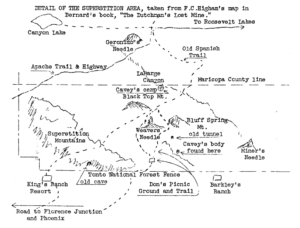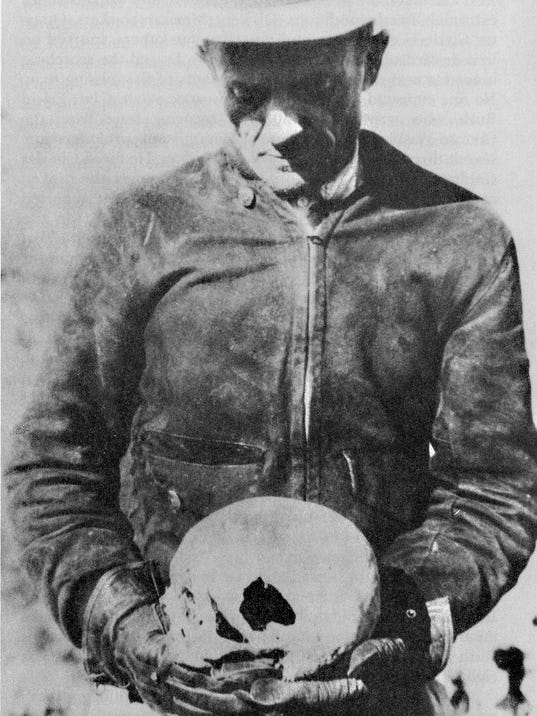So, at a certain point in history, you can say “okay, this is the thing that put this on the map.” There’s certain stuff that just wouldn’t be remembered today if that one thing hadn’t happened. Like the 20th century frenzy over Anastasia possibly surviving the Russian Revolution because one woman in 1921 came forward claiming to be her, and a slew followed. For the Lost Dutchman’s mine, and perhaps all the Superstitions, that one incident is the disappearance and tragic end to Adolph Ruth in the 1930s.
Adolph Ruth was an experienced hiker, not unlike our Rose, and was a well-known treasure hunter, capitalizing on the remnants of the Gold Rush era. The story begins with Ruth’s son, however, back in 1912. Ruth’s son, Erwin, was a lawyer who offered legal advice to a man named Pedro Gonzalez, who, in return, told Erwin about the mine and gave him to heirloom maps to the location as Gonzalez claimed maternal descent from the family. Erwin passed it on to his father who took great interest in another conquest for lost treasure in the wilderness.

In the early summer of 1931, Ruth, elderly and walking with a cane, set out on a two week journey into the mountains to follow the map. Ruth met many oppositions to his trek from friends, noting that at 66 years old and somewhat handicapped, it was a perilous feat. But, ever the adventurer, Ruth journeyed on. Two weeks passed and there was no sign of Ruth (is this starting to sound familiar?). Several search parties were dispatched but no trace of hims turned up as summer ended and fall brought nothing as well.
And then December of that year hit. A human skull was founded in the Superstition Wilderness. It was examined by respected anthropologist Dr. Ales Hrdiicka who compared the skull to Ruth’s dental records and several photos.

He positively id’d the skull as Ruths. The chilling part though, is what Dr. Hrdiicka discovered that did not match any picture of Ruth: two bullet holes in the head from a high powered rifle. The doctor noted that the wounds indicated the weapon had been fired at point blank range. By January 1932, it only got more bizarre.
More human remains were discovered that month, the body missing its head. The scattered remains were identified as Ruth’s by the personal effects and the pins in the hip which matched the ones Ruth had that forced him to walk with a cane. Also discovered was a journal and a pistol, with no missing shots. The map was missing. Within the journal was contained a handwritten message on Ruth’s checkbook claiming he found the mine along with the message: “Veni, vidi, vici.” Ruth’s death was ruled accidental, the result of heat or hunger, but that didn’t satisfy many in the town, especially his family.
What we can conclude from this is that Ruth did not kill himself, despite one assertion by authorities that that was the case. Even if Ruth had someone managed to reload his own pistol after shooting himself in the head (to account for the lack of missing rounds), it doesn’t explain that the wounds match that of a much more high powered gun. And how exactly did he go about removing his own head after doing so? To this day, most reject the theory that he died of any sort of suicide or natural cause in the desert. The story made national news after that and remains a mystery of history.
So, what do we glean from this? At the very least, people have been willing to kill for their belief in this mine. I have no doubt Ruth was murdered, like prospectors of old, for gold. We also have the most recent story of the Peraltas from a somewhat direct source thanks to Pedro Gonzalez. This fabled map, is still nowhere to be seen almost a hundred years later and the mysterious murderer, still anonymous. But Ruth’s story strangely preludes Rose’s own–at least I hope it doesn’t end the same way.

2 Comments
The Adolph Ruth has many hidden facts. The one fact that is true that is true is Adolph Ruth did find the Lost Dutchman Gold Mine. Written in pencil below the words “Veni, Vidi, Vici” (“I came, I saw, I conquered.”) “about 200 feet across from cave.” In the book “THE LOST DUTCHMEN MINE and PEG LEG PETE MINE” (ISBN: 978-1-4787-9011-2) it states that the Lost Dutchman Mine and the Dacite Cliffs Mine may be one and the same. Note: The Dacite Cliffs Mine has a cave located approximately 2oo feet the mines entrance. Sincerely, CRAZY OLD MAN
If you really want to find the LDM, I’ll give you some clues? Believe anyone who says that the Lost Dutchman’s goldmine is not in the superstitious mountains. Believe that the gold mine is towards the east and the left sidewall of weaver’s needle point towards the mine? Believe Jacob Waltz and the saddle he drew on his map towards the east? Believe that the goldmine lies behind the saddle which sits above thunder mountain. Believe in the Arizona Report who posted a photo of the saddle a few years ago. This photo has the proof of the saddle above the right side in the blue? If you find it then you know why you have not found the goldmine.